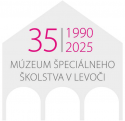In October 2014, the Museum of Special Education in Levoča opened a unique exhibition dedicated to an extraordinary personality of the beginning of the 19th century – Alois Klar, the founder of the Institute for Blind Adults in Prague on Mala Strana.
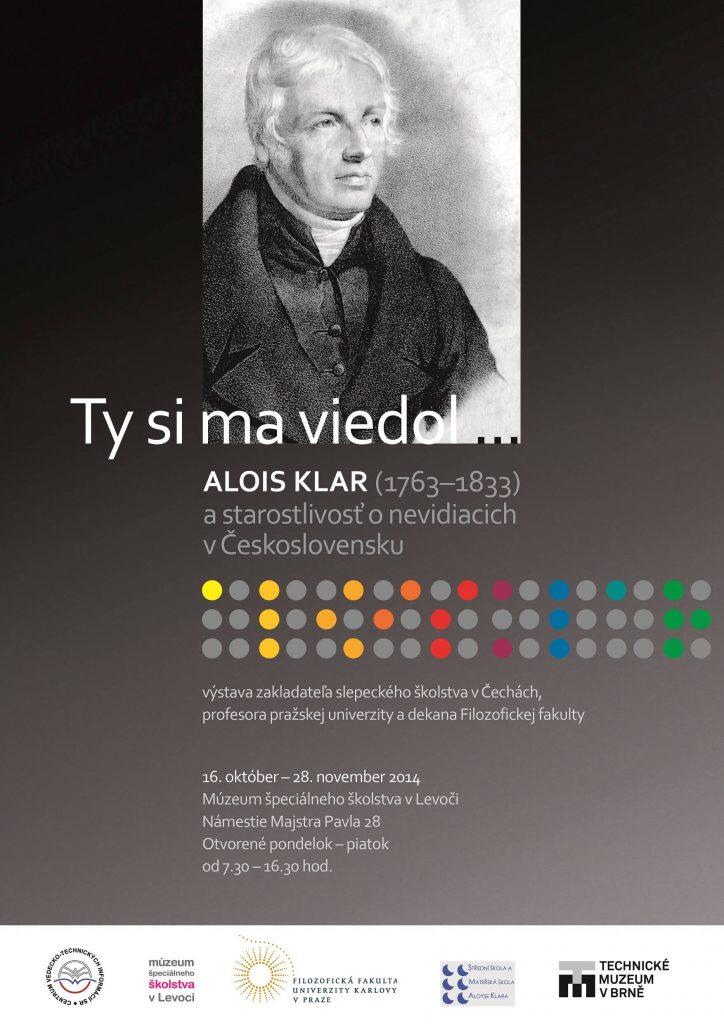
The exhibition was realized with Czech partners – the Faculty of Arts of Charles University in Prague, the Alois Klar Middle School and Kindergarten in Prague Křeč, and the Technical Museum in Brno.
The exhibition presented the life and work of the founder of care for the visually impaired in Czech Republic, educator and patron Alois Klar. It also reminded his followers who continued the work of their father and grandfather, too. The 28 panels included portraits of Alois Klar, members of his immediate family, examples of Braille, a publication published for the centenary of the Klar Institute for the Blind in Prague from 1932, rare, historical teaching aids, typewriters, board games, a wooden folding map of Central Europe, the Prague Table and others used by the visually impaired in Czech and Slovak institutions in the 19th century.
Hundreds of visitors have seen the exhibition in Rumburská Loreto and on the premises of Litoměřice Castle since last year’s premiere in the Karolín Cross Corridor of Charles University. It will be available in the Museum of Special Education in Levoča until the end of November 2014.
Who was Alois Klar?
Alois Klar was born on April 25, 1763, in the town of Úštěk near Litoměřice, as the third child of Josef Klar and his wife Apollonia, née Bastlova.
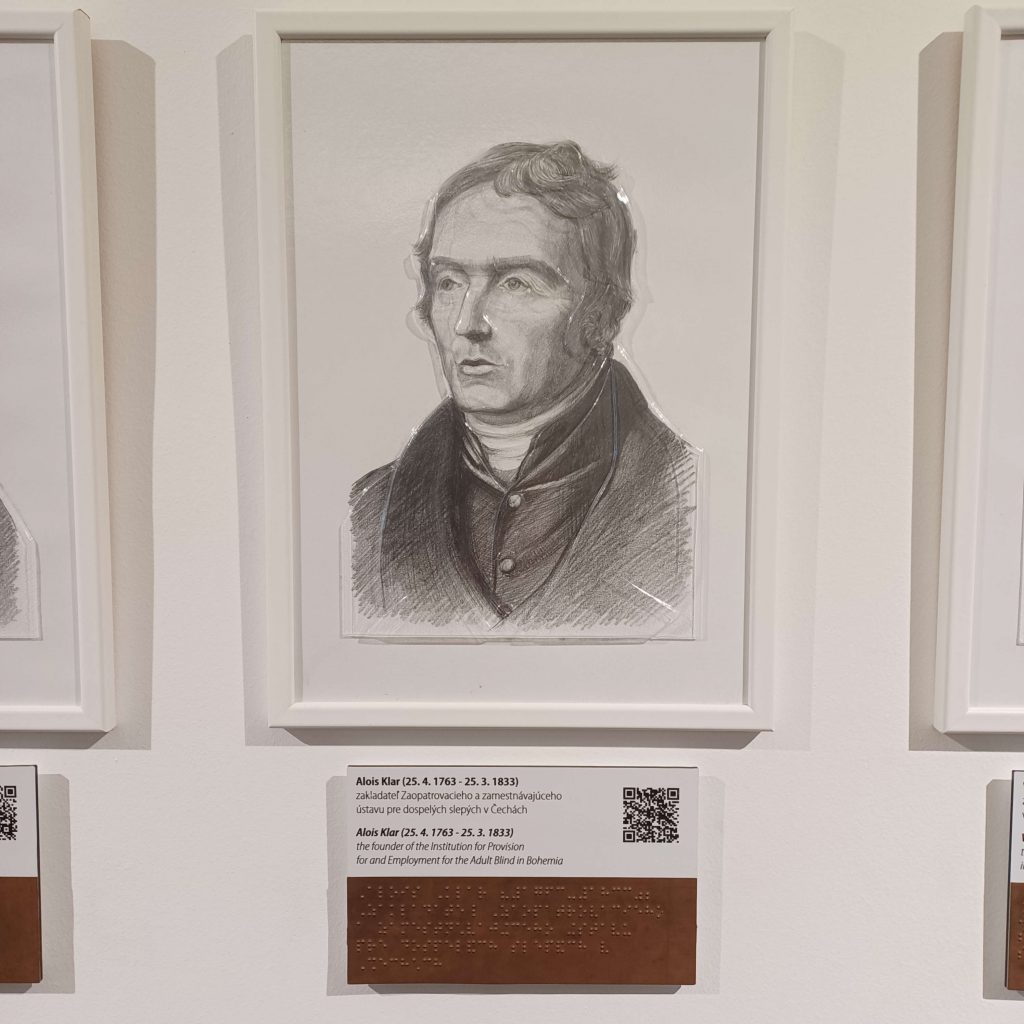
Alois, who read a lot as a child, was clever. During the first years in the city school, which did not meet his interests, he started teaching Latin. As a self-taught person, he mastered it in a relatively short time. In 1774-1779, young Alois continued his studies at the Litoměřice grammar school. In this context, Alois is mentioned not only as a student but also as a high school professor in 1786-1805. After completing his high school studies, Klar received the first prize in all subjects – the highest possible academic award. He loved history and languages, especially Latin and French, which he also learned all by himself. However, high school years also brought a dark side to Klar, because as a first-year student, he suffered an unfortunate fall, injuring one of his ribs with permanent consequences.
Not even illness prevented Klar from continuing his university education. In the fall 1779, he began studying philosophical sciences at the University of Prague. He achieved excellent academic results, and on 31 August 1782 he was ceremoniously graduated with a Master of Liberal Arts and Philosophy. Klar decided to continue his 5-year study of theology, during which he learned Greek brilliantly. In 1783, Klar entered the archbishop’s seminary as an alumnus, i.e. a university graduate, where he spent three intensive years. Unfortunately, in 1785, Klar had health problems, and since Klar could not become a priest, he decided to be a teacher. He returned to Litoměřice, where he took the position of professor of grammar at the gymnasium. Later, he became a professor of rhetoric and poetics for a full 20 years, until 1806.
In 1806, the situation in Litoměřice and at the grammar school changed with the adoption of a new constitution, according to which only priests could teach religion. In that period, Klar was approached by Charles-Ferdinand University in Prague. He considered his abilities and possibilities and applied for an audition for the department of general history at the University of Prague. Although he did not get the chair, he was assigned the chair of classical literature, Greek and Latin philology. On December 9, 1806, Klar began writing a new, important chapter in the history of Prague and the university.
In Prague, Klar began to pay more attention to the emergency conditions of some students, and in 1816 led to the establishment of the Support Student Association at the university, which lived entirely on donations. The association was financially supported by Klar and based on his charitable activities. He gained the respect and admiration of the young intelligentsia, e.g. and Karel Hynk Mácha, who dedicated a poem to him.
Klar became its dean in the academic year 1820/1821, 14 years after his introduction to the philosophy faculty.
Klar and visually impaired
Specialized institutions for the visually impaired were established in Europe in the 18th century, e.g. Paris 1784, Liverpool 1790, Edinburgh 1790, London 1800, Vienna 1804, Berlin 1806, St. Petersburg 1807, Prague 1807 (Prague Private Institute for the Poor Blind and Visually Impaired – the oldest institution for the blind in Hradčany). The first Prague institute was created thanks to a special coincidence of circumstances. At that time, a collection was announced in Prague, the proceeds of which were to be used for the construction of the second bridge over the Vltava. Unfortunately, the construction project mysteriously collapsed and the funds were transferred to the establishment of the Hradčany Institute. The initiative for the establishment was suggested by professor of statistics Josef knight Máder, who lost his sight in adulthood. His proposal was supported and approved by Count Wallis, the outgoing Czech ambassador in Paris at the time, who knew the functioning institute for the blind in Paris. Alois Klar himself, as a member of the board, took part in drafting the first statutes of the institute. Prokop Knight von Platzer became the first director of the institute.
Klar came up with a proposal to establish a kind of continuation of the Hradčany Institute in the sense of an “employing and providing care” facility. In 1831, he presented a comprehensive vision of an institute for the visually impaired, and he received support from Empress Karolina Augusta, who supported the establishment of the institute with the first financial contribution. Klar substantiated his proposals with the results of a similar facility, the Viennese Private Association of Care and Employment Institute for Blind Adults, operating since 1829.
On November 7, 1831, the 68-year-old Klar gave up teaching and resigned from the post of a public university professor, forced by his deteriorating health. His wife Rosina and son Pavel Alois helped him in every possible way.
The day of the institute’s opening was uncompromisingly approaching, and an adequate object was still missing. Klar made a decisive decision and in May 1832 leased a building on Velkoprievozská námestí in Prague. Knitting and spinning flax became a trial occupation for the visually impaired. The great day of the ceremonial opening of the institute took place on October 4, 1832. The regional presidium approved the opening of the Care and Employment Institute for blind adults in Bohemia on this day. The confirmation of the constitutional and federal statutes took place on December 22, 1832.
In March 1833, Klar still planted three trees in the institutional garden, and five days later, on March 25, 1833, after midnight, he breathed his last.
Continuators of Klar’s work
Alois Klar got married on 9/9/1800. Rosina Schőnová, the daughter of a wholesaler in Rumburk, became his wife for life. A year later, on June 10, their son Pavel Alois was born. Then three more sons and one daughter. However, except for Pavle, none of them lived to adulthood.
In addition to raising the eldest Pavol Alois, the couple also adopted and raised a little girl found in the bushes near the Elbe River. Baptized as Rosina Franziska Barbara Josefa, she went to Vienna at 23.
The fulfillment of Klar’s ideas and their development was carried out by his eldest and only surviving son, Pavel Alois Klar. Although he studied law and chamber science at the University of Prague and was a successful concept trainee or regional commissioner of the office in Prague, he continued his father’s work in care for the visually impaired. He inherited a rented building from his father on Velkoprievozský square and five blind people in it. At that time, the functioning of the institute depended on 17 contributing members, and the provisional capital was 12,600 florins. This provisional solution was solved by Emperor Francis I, who promised help during a personal visit to the institution. He thus appreciated Klara’s tenacity and hard work for the benefit of the blind and donated a barren plot of land between the Daliborka tower and the Old Castle stairs. A new building of the Klarov Institute in Mala Strana, today’s Klarov (Metro stop Malostranská), was later built on this land.
It seemed that the institute would prosper for a long time, but the opposite was true. In 1836-1863 all-new financial resources were absorbed by the building on Klarov, which counted on a staff of up to 300 blind people, including staff, and the institute began to drown in debts.
The building on Klarov (currently the seat of the Czech Geological Library), which they started to build in 1836, still stands out today with its sober Empire facade. It is a two-story building, on which the relief Tobias heals his father’s blindness was installed in the middle gable of the main facade. The side wing of the building was only completed in 1885. The building served the blind until the middle of the 20th century when they moved to a new building in Prague Krč, where the successor of the historic Klarovno Institute – the Aloys Klara Middle and Kindergarten School – still operates today.
Pavel Alois Klar in In 1834, he married Mária Karolina, born Countess Vratislavová from Mitrovic. They had three sons: Pavel Zděnek, Karel Václav and Rudolf Mária.
Pavel A. Klar, unfortunately, fell ill in 1845 due to work strain and became completely paralyzed in his lower limbs. He moved only in a wheelchair and resigned from the post of director of the institute.
In 1844-1857 the institute almost disappeared because it was drowning in debts, and at the same time, someone thought that the building could also serve as a cholera hospital on the Mala Strana. Fortunately, this did not happen, even though the management of the institution had to give up the entire floor in favor of the inmates of the Italian workhouse.
Klar’s Institute experienced great fame in 1857 on the 25th anniversary of its existence, when Pavel A. Klar, his wife, and three sons dedicated a brand new statue of St. Wenceslas to Prague’s Charles Bridge.
Pavel Alois Klar died on November 5, 1860. According to his last will, his successor was his youngest son Rudolf Maria Klar, who was only 16 years old at the time of his father’s death. Therefore, the management of the Institute was taken over for a while by a distant relative, official Jan knight from Běšín. However, with the mentality of a soldier, he introduced military methods, practices, and punishments in the institution.
Changes in the constitution did not occur until around 1880, after the death of Jan knight from Běšín, when Rudolf Maria Klar became more involved in management. For example, he initiated a private census of the blind through district officials. In 1874, 4,031 blind people were living in the Czech Republic.
In those years, there were 60 blind people living in the institution engaged in manual work. After 17 years of the management of the institute by Rudolf M. Klar, their number increased to 112. Most of them worked in workshops and learned various crafts. The newly arriving blind people were given the opportunity to study all the basic subjects of the municipal school.
Rudolf M. Klar was different from his grandfather and a father. He was a creative, practical professional. Among his brilliant ideas was the establishment of a kindergarten for the blind, thus filling the last gap in the care of the blind. He followed any events concerning the blind abroad, e.g. Assemblies of blind teachers in Germany. Historically, the first such assembly in Prague was held under his auspices in June 1889. In 1884, literary and technical education of lagging behind blind and later blind people began in the institute. The name of the institute changed to the Continuation School and Technical Teacher’s Institute.
Even in 1888, the institution left the chain of specialized care institutions, as it offered a whole range of specialized production industries, and blind inmates obtained a professional qualification after graduation, thus complete independence and the ability to support themselves.
During the management of the institute by Rudolf M. Klar, the historical Prague Table (the year 1886) was created on the grounds of the institute, made by Václav Malý, a teacher at the institute. It is a two-leaf, metal, 21-line table that was used for blind people to write Braille. Its modern alternative was a plastic table, lighter, with fewer lines.
Rudolf Mária Klar died of nephritis on October 3, 1898.
Alois Klar’s legacy
Alois Klar remained known to the general public as the dean of the Faculty of Arts of the Charles-Ferdinand University in Prague (today’s Charles University), as the founder of the Institute for the Blind, and the founder of supporting student associations and foundations for budding painters and sculptors. His emphasis on the integration of the blind into society was unique in this period, and even today it is seen as the first attempt to integrate the blind.
Photos from the exhibition at the Museum of Special Education in Levoča:
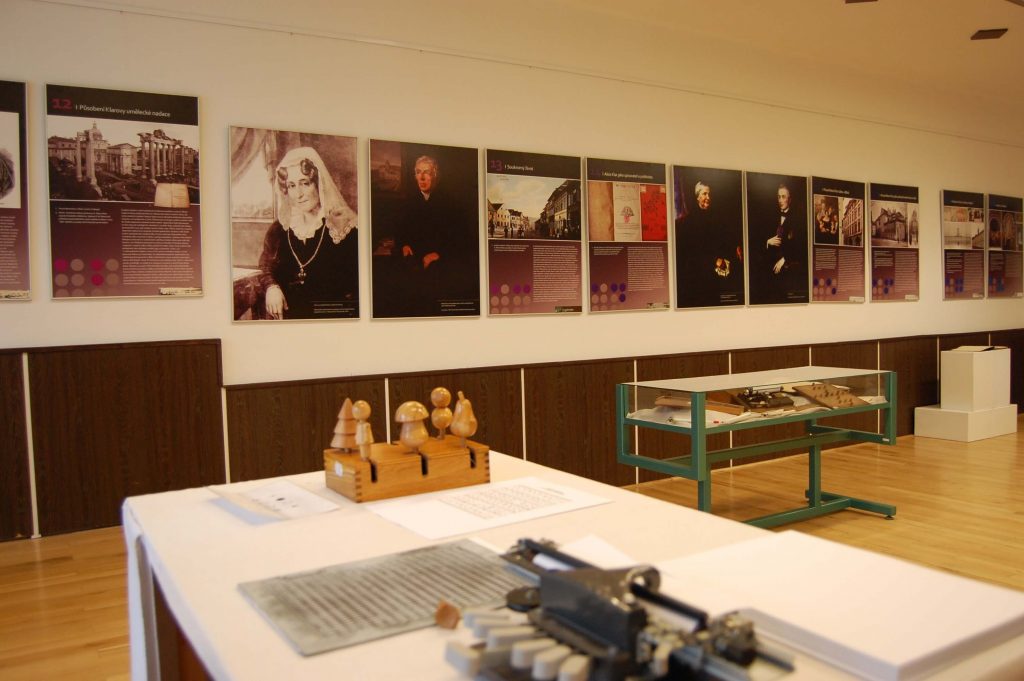
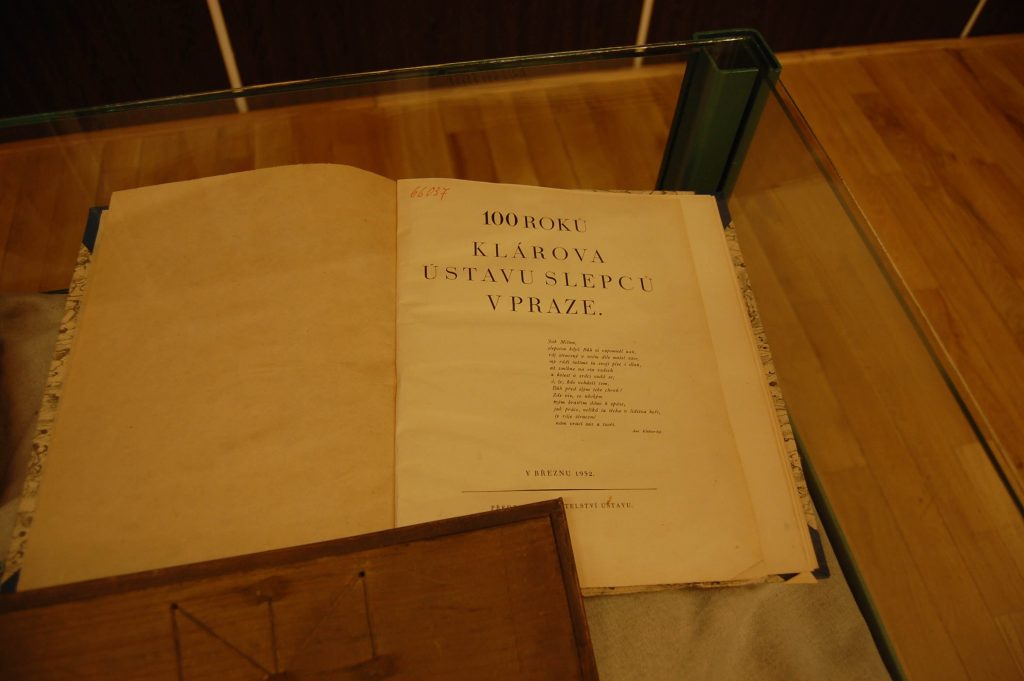
Bibliography
100 roků Klárova ústavu slepců v Praze, vydaná v březnu 1932, nákladem Klárova ústavu slepců v Praze, tiskem Edvarda Leschingra v Praze II., počet strán 74.
Péče o děti s vadami zraku, „II. Vývoj péče o slepé“, str. 14-17, rok 1957
Listinné dokumentačné materiály Múzea špeciálneho školstva v Levoči „Prvé ústavy pre slepých“ (bez uvedenia autora).
Author: Mgr. Štefánia Petreková
